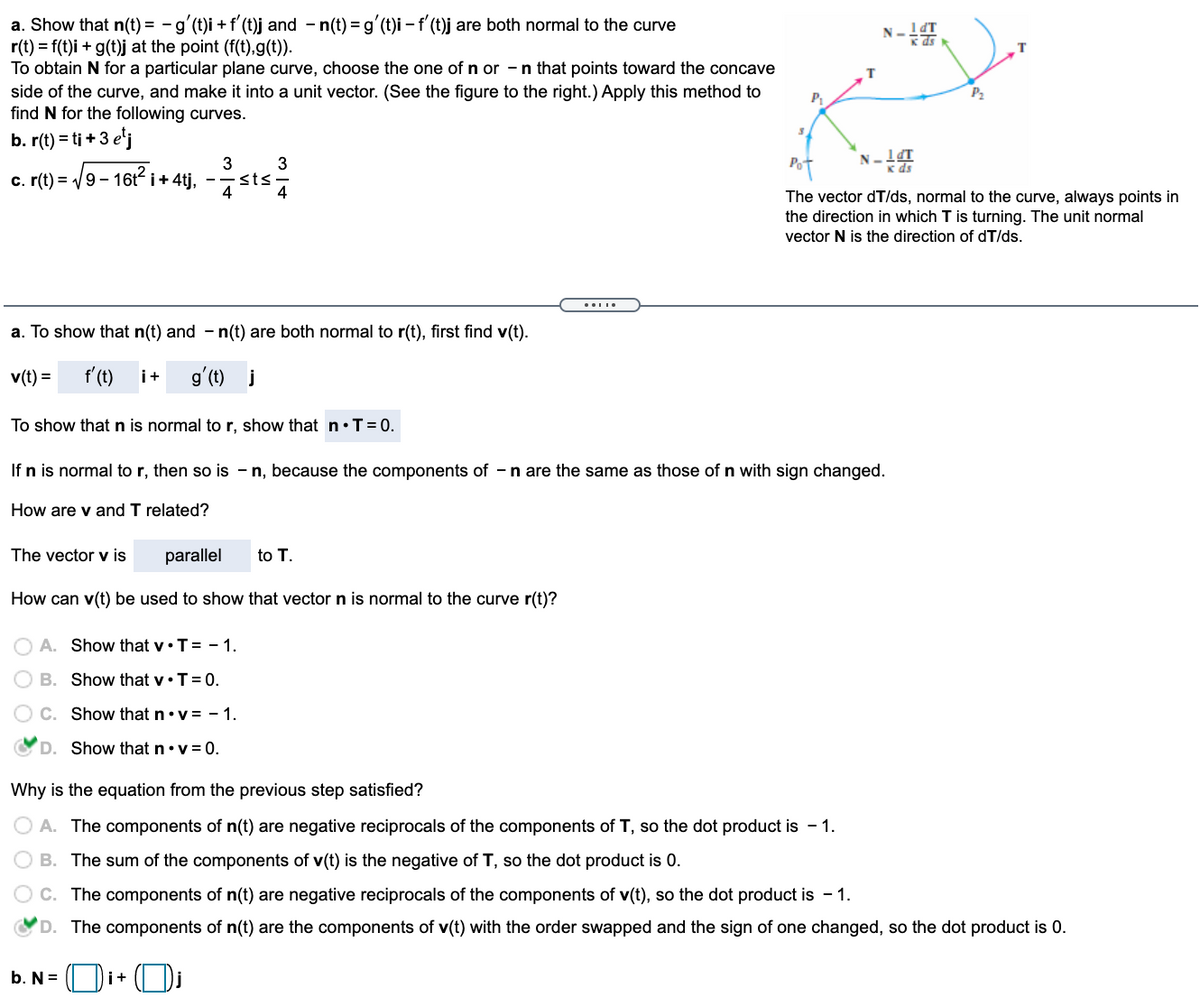a. Show that n(t) = - gʻ(t)i + f'(t)j and - n(t) = g'(t)i – f'(t)j are both normal to the curve r(t) = f(t)i + g(t)j at the point (f(t),g(t)). To obtain N for a particular plane curve, choose the one of n or -n that points toward the concave side of the curve, and make it into a unit vector. (See the figure to the right.) Apply this method to find N for the following curves. P. b. r(t) = ti + 3 3 e'j 3 3 Pot K ds c. r(t) = /9 – 16? i + 4tj, -sts- The vector dT/ds, normal to the curve, always points in the direction in which T is turning. The unit normal vector N is the direction of dT/ds.
a. Show that n(t) = - gʻ(t)i + f'(t)j and - n(t) = g'(t)i – f'(t)j are both normal to the curve r(t) = f(t)i + g(t)j at the point (f(t),g(t)). To obtain N for a particular plane curve, choose the one of n or -n that points toward the concave side of the curve, and make it into a unit vector. (See the figure to the right.) Apply this method to find N for the following curves. P. b. r(t) = ti + 3 3 e'j 3 3 Pot K ds c. r(t) = /9 – 16? i + 4tj, -sts- The vector dT/ds, normal to the curve, always points in the direction in which T is turning. The unit normal vector N is the direction of dT/ds.
Algebra & Trigonometry with Analytic Geometry
13th Edition
ISBN:9781133382119
Author:Swokowski
Publisher:Swokowski
Chapter11: Topics From Analytic Geometry
Section: Chapter Questions
Problem 18T
Related questions
Question
Find B and C

Transcribed Image Text:c. N= Di+C

Transcribed Image Text:a. Show that n(t) = - g'(t)i + f' (t)j and - n(t) = g'(t)i -f (t)j are both normal to the curve
r(t) = f(t)i + g(t)j at the point (f(t),g(t)).
To obtain N for a particular plane curve, choose the one of n or -n that points toward the concave
side of the curve, and make it into a unit vector. (See the figure to the right.) Apply this method to
find N for the following curves.
K ds
T.
b. r(t) = ti +3 e'i
3
Pot
N -.
.2
c. r(t) = /9 – 16ti+ 4tj,
sts
%3D
4
The vector dT/ds, normal to the curve, always points in
the direction in which T is turning. The unit normal
vector N is the direction of dT/ds.
a. To show that n(t) and - n(t) are both normal to r(t), first find v(t).
v(t) =
f'(t)
i+
g'(t) j
To show that n is normal to r, show that n•T=0.
If n is normal to r, then so is - n, because the components of -n are the same as those of n with sign changed.
How are v and T related?
The vector v is
parallel
to T.
How can v(t) be used to show that vector n is normal to the curve r(t)?
A. Show that v•T= - 1.
B. Show that v•T= 0.
C. Show that n•v = - 1.
D. Show that n•v = 0.
Why is the equation from the previous step satisfied?
A. The components of n(t) are negative reciprocals of the components of T, so the dot product is - 1.
B. The sum of the components of v(t) is the negative of T, so the dot product is 0.
C. The components of n(t) are negative reciprocals of the components of v(t), so the dot product is -1.
'D. The components of n(t) are the components of v(t) with the order swapped and the sign of one changed, so the dot product is 0.
b. N =
i+
Expert Solution
This question has been solved!
Explore an expertly crafted, step-by-step solution for a thorough understanding of key concepts.
This is a popular solution!
Trending now
This is a popular solution!
Step by step
Solved in 2 steps with 1 images

Recommended textbooks for you

Algebra & Trigonometry with Analytic Geometry
Algebra
ISBN:
9781133382119
Author:
Swokowski
Publisher:
Cengage

Algebra & Trigonometry with Analytic Geometry
Algebra
ISBN:
9781133382119
Author:
Swokowski
Publisher:
Cengage